
frame - Something
made to enclose a picture
or a mirror; or an enclosure
composed of parts and joined
together; or to make such things.
![]()
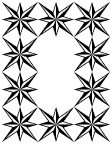
![]()
Pictures are placed in frames to set them off from their surroundings, to honor or decorate them, and to protect them from harm.
![]()
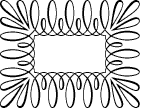
![]()
The frame for any work of art should be designed or chosen with many things in mind, including:
Many works of art have been reframed over the years. Very old paintings are often found to be no longer in their original frames.
When a work is found to be in a frame made or chosen by the artist who produced the work, one is generally wise to retain that frame.
A ![]()
 painting's stretcher is also sometimes
called a frame.
painting's stretcher is also sometimes
called a frame.
Moldings for picture frames are mitered so that their corners are right angles.
Examples:

Painting: Botticelli (Alessandro di Mariano
Filipepi) (Italian, Florentine, 1444/45-1510), The Last Communion of Saint Jerome, early
1490s, tempera and gold on wood
panel, 13 1/2 x 10 inches (34.3
x 25.4 cm), Metropolitan Museum of Art, NY. This exceptionally
fine frame has a painted
lunette by Bartolomeo
di Giovanni, who not only collaborated
with Botticelli on at least one occasion but copied
this picture as well. The frame may have been made for one of
the copies. See Renaissance.

Leonardo da Vinci (Italian, 1452-1519), Madonna with a Flower (Benois Madonna),
begun 1478, oil on canvas, 19 1/2 x 12 1/2 inches
(49.5 x 33 cm), State Hermitage Museum, St. Petersburg, Russia.
See sfumato.

Italian (Siena?), Mirror
Frame, c. 1490-1500, carved and gilt
poplar, height 24 1/4 inches
(61.6 cm), width 13 7/8 inches (35.2 cm), diameter
circle 6 inches (15.2 cm), Metropolitan
Museum of Art, NY. See mirror
and tondo.

Italy, Florence, Tabernacle Frame, c. 1530 (?), walnut;
overall size: 29 3/4 x 14 1/2 inches (75.6 x 36.8 cm); sight
size: 11 x 8 inches (27.9 x 20.3 cm); rabbet
size: 11 1/2 x 8 1/2 inches (29.2 x 21.6 cm), Metropolitan Museum
of Art, NY.
![]()

![]()
Dutch, Antwerp, Miniature frame, 1575-1600, fruitwood,
5 x 4 inches, Minneapolis Institute of Arts.
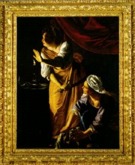
Artemisia Gentileschi (Italian, 1593-1651/53),
Judith and Her Maidservant with the Head of Holofernes,
c. 1625, oil on canvas,
1.8 x 1.4 m (72 1/2 x 55 3/4 inches, Detroit Institute of Art,
MI. See Baroque,
Caravaggisti, and feminism and feminist art.
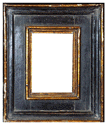
Italian, Frame, 17th century, carved,
silver leaf, and polychrome,
opening size: 5 x 3 3/8 inches, molding width 2 3/8 inches. This
frame has what is called a cassetta profile: its flat frieze
and raised inner and outer edges originated in 15th century Italy.
It became the basis for many frames thereafter, including American
Impressionist frames of the early 20th century. This small black
polychromed and parcel gilt cassetta frame is from 17th century
Italy.

Painting: Joseph Siffred Duplessis (French,
1725-1802), Benjamin Franklin (1706-1790), 1778,
oil on canvas;
oval, 28 1/2 x 23 inches
(72.4 x 58.4 cm), Metropolitan Museum of Art, NY. Exhibited in
the Salon of 1779, this portrait
remains in its original
frame, which includes the attributes
of Liberty, Peace, and Victory, along with the simple inscription
"VIR" -- the man.

Painting: Hubert Robert (French, 1733-1808),
The Ruins, 1777, oil
on canvas, diameter
32 3/4 inches (83.2 cm), Metropolitan Museum of Art, NY. See
Rococo.

Pere Borrell del Caso (Spanish, 19th century),
Escaping
Criticism, 1874, oil
on canvas, Banco de España,
Madrid. In advance of art
criticism, this boy (the painting itself) appears to escape
his (its) frame -- both examples of a trick called trompe
l'oeil.
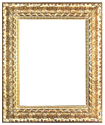
Italian, Frame, 19th century, carved
and gilded, opening size: 27 1/2
x 21 inches, molding width: 5 1/2 inches. This simple elegant
acanthus leaf design is
based on 17th century Bolognese frames. It is well suited to
pre-19th century European drawings,
and some works on paper by Picasso or Matisse. This style frame
was often used by John Singer Sargent. See portrait.

American, Frame, c. 1930, a flat linear 3-stepped
profile, carved and silver leafed,
opening size 13 5/8 x 9 3/8 inches, molding width 2 inches. As
art embraced the growth of machine technology in the early 20th
century frames echoed the forms and surfaces of machinery. See
abstract art and Precisionism.
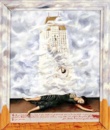
Frida Kahlo, El suicido de Dorothy Hale (The Suicide of Dorothy Hale), 1939, oil on Masonite panel with painted frame, Phoenix Art Museum, AZ. The subject is Dorothy Hale, a society woman who became despondent and threw herself from the window of her New York apartment. Kahlo describes the horrible event in the inscription, which is written in Spanish. The English translation is: "In New York City on the 21st of October 1938, at 6:00 in the morning, Dorothy Hale committed suicide by throwing herself from a very high window in the Hampshire House. In her memory [...], this retablo was executed by Frida Kahlo." Part of the third line has been erased. Another part of the painting also was changed: an angel once appeared at the top. These erasures were made in response to the violent reaction from Clare Boothe Luce, who commissioned the work. See memorial, Mexican art, and retablo.

Wayne Eagleboy (American, Onandaga, contemporary), We the People, 1971, acrylic paint and barbed wire on buffalo hide, Art Wagon Gallery. Contemporary Native American Wayne Eagleboy's version of the US flag is framed with fur, and bears portraits of two Indian men behind a screen of barbed wire.
![]()
Other senses of the word "frame":
A picture in a series of pictures, such as a comic strip, filmstrip, or set of illustrations.
And, a single picture on a roll of photographic or movie film; or the total area of a complete picture on a video screen.
Also see bole, cartouche, escutcheon, frisket, glass, hammers, Kunstkabinett and Kunstkammer, mat, molding, mount, mullion, nail, niche, passe-partout, preparator, quadro riportato, shadow box, wireframe, wood, and Wunderkabinett and Wunderkammer.
https://inform.quest/_art
Copyright © 1996-![]()